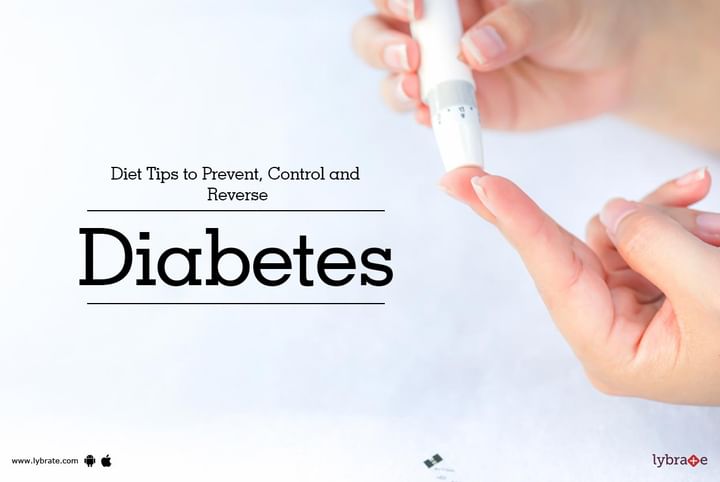Diet Tips to Prevent, Control and Reverse Diabetes
Diabetes is a chronic progressive condition of glucose abnormality. A patient with diabetes loses the capacity to regulate his blood glucose and hence there are high circulating levels of glucose in his blood. This is either due to less production of insulin hormone or the body loses the sensitivity to respond to the insulin hormone normally or both. The incidence of diabetes in general population is increasing fairly rapidly due to our erratic work schedule followed by lack of exercise and sleep.
Further, it is aggravated by our overindulgence in high sugary food and junk food. But, the good news is that you can control and even reverse diabetes (at least in the initial stages) by following some simple dietary tips. People have a misconception that “Dieting = Starving “. This is completely wrong. Further people also think that to enhance the taste of any dish it should have lot of oil, ghee, butter. This is again wrong. You can make your dish delicious even by using healthy ingredients and reducing the fats, oil and sugar in it. You can enhance the taste by using spices which are good for health as well as for digestion. Following a healthy diet means that you are eating nutritious food which is both healthy and tasty.
Here are a few dietary tips you should follow to keep your blood sugar levels in check:
- Include plenty of vegetables in your diet, more the better. At least half of your plate should be filled with vegetables; this can be in salad form or can also be in form of curries/subzi which is prepared using less oil. Eating vegetables helps to bulk you up, you do not feel hungry and thus you would not be consuming high-calorie food like fats or carbohydrates. Vegetables have plenty of fibre. Eating vegetables also help to release the glucose from carbohydrates slowly so that your blood glucose levels do not fluctuate much. Green leafy vegetables are excellent sources of Vitamin-A. Beans are rich sources of protein too.
- Carbohydrates are needed for your body; you derive the necessary energy from these carbohydrates. But you should consume them in a portion of about 1/3-1/4th of your plate – in other words, 2-3 phulkas, a bowl of rice etc. Use whole grains rather than polished grains. Whole grains of rice, wheat will release glucose into your blood in a slower fashion than polished rice or wheat. Whole grains also have much needed essential vitamins and minerals, the polished grains lose these vitamins during the process of dehusking and polishing. Include plenty of millets like jowar, bajra, Ragi/pearl millets etc. Include oats, quinoa, brown rice, broken wheat, wheat rava, etc. Avoid food items made with maida.
- Make sure you eat pulses. Pulses are a good source of protein. Sprouts are filled with protein and fibre. Try adding sprouts to your rice, noodles or salads. Non-vegetarian food is a very good source of protein. You can take egg, chicken and fish. Avoid mutton or organ meat.
- Restrict animal fats like butter, cheese. Also, restrict large quantities of oil and ghee. Avoid Vanaspati/dalda.
- Milk is the perfect combination of protein and carbohydrate and can control blood sugar levels. Take a glass of milk when you experience low sugar symptoms. People who don't drink milk can consume yoghurt/curd or buttermilk. Milk, curd and buttermilk are good sources of calcium.
- Consume fruits such as papaya, pear, orange, guava, small bowl of musk melon, water melon, apples, etc. Don’t eat fruits which have high sugar content such as mangoes or grapes, custard apple, chikoo.
- Foods which are rich in Omega-3 fatty acids are excellent in combating diabetes. These include flax seeds and nuts. You can take 5-7 nuts everyday like almonds, cashew nuts, walnuts etc.
There are few everyday tips which you should follow:
- Make sure to have small frequent meals comprising of high-fibre and low in carbohydrate foods. This is to make sure that you do not experience low sugar levels as you would be taking medicines for your diabetes.
- Methi or fenugreek seeds are good for glucose control too. Soak one tablespoon of the seeds in 100 ml of water overnight and have it in the morning.
Tip for sticking with a diabetes-friendly diet plan:
- First and foremost, take small, manageable steps.
- Choose one aspect you want to work on. For e.g. if you eat junk food 4-5 times a week, make a conviction of consuming junk food only once a week. After you have mastered this, then go for another aspect. This is to make sure that you are not overwhelmed with the prospect of lot of changes and that you can take pleasure in the fact that you could make one positive change. This will provide you enthusiasm to likewise make other changes.
- The mantra that you should be following should be “small portions of food”. So instead of helping yourself to 3 ladoos or 2 bowls of kheer, you should limit yourself to 1 ladoo or ½ ladoo. That way you will still derive the pleasure of eating the ladoo (and satisfy your craving) but you would not have consumed that many calories as you would have done if you had eaten 3 ladoos.
- As well as following a diet, make sure that you get some exercise. It is recommended to exercise at least 45 minutes every day for 5 days of the week. You can go on fast walk, running, jogging, cycling, swimming etc.
- You can even break your exercise time into small chunks – maybe you can exercise 15 minutes 3 times a day. If you have never exercised start with 5-10 minutes of walking, you can then gradually increase the intensity of the exercise.



+1.svg)
